MeldaProduction MTurboReverb Handleiding
MeldaProduction
Audiosoftware
MTurboReverb
Bekijk gratis de handleiding van MeldaProduction MTurboReverb (182 pagina’s), behorend tot de categorie Audiosoftware. Deze gids werd als nuttig beoordeeld door 15 mensen en kreeg gemiddeld 4.5 sterren uit 8 reviews. Heb je een vraag over MeldaProduction MTurboReverb of wil je andere gebruikers van dit product iets vragen? Stel een vraag
Pagina 1/182

MTurboReverb
Overview
MTurboReverb is probably the most powerful algorithmic reverb ever made. Most reverbs are based around a single algorithm, for which you
can change certain properties, such as reverb length. That makes them very limited in terms of use and sound. MTurboReverb comes with
currently about 100 reverb designs (based on different, often multiple, algorithms), complex and simple, realistic and creative, large and
small, featuring all kinds of advanced factors such as pitch shifting or frequency shifting. So in a way it serves as 100 different reverb plugins
(or hardware units) and more are being created.
All these reverbs are available by selecting one of the devices on the main screen (called Easy screen). All of them share a very similar
GUI, so that you in fact instantly learn to use all of these reverbs just by learning one. You can browse the available reverbs simply by
clicking on them on the left side of the Easy screen. Use the Display locks button on top of the list to show locks next to most parameters,
which let you lock them so they stay the same while browsing the reverbs. For instance, if you are using the reverb as a send, which was
quite common mainly to save CPU, you will want to set the Dry/Wet to 100%. To do that, just click the lock button next to the Dry/Wet
control and it will stay at that value while changing reverbs.
Most of the reverbs feature everything you'd usually need, from Dry/Wet and Length controls through to parameters of early and late
reflections and advanced dynamics processing, all available instantly from the Easy screen and documented below.
Under the hood
MTurboReverb does all that magic by providing a simple programming language that lets you actually define the algorithm that powers the
reverb. It has been designed in such a way that creating these algorithms is actually very simple. In fact, each algorithm is defined by a
single line! Despite all the versatility the engine is actually extremely CPU efficient. Anyway do not worry; you don't need to do any
programming yourself, unless you feel especially creative. The devices will probably keep you busy for a long time.
The Edit screen provides access to the underlying functionality and contains several modules. First there are 4 ER ( Early Reflection)
sections. These are more graphical and let you define the early reflections directly via a tapped delay line. Presets for these sections are
available and there are hundreds of predefined ERs. Besides the classic tapped delay line, traditionally used for producing early reflections,
each ER sections actually provides additional algorithms such as Diffuser or Room, so that you can actually design the whole reverb just
using the ER sections. But that would exploit only a small part of the plugin's potential.
The main power lies in the 6 LR (Late Reflection) sections. So in a way there are up to 6 reverbs running in parallel, and that's not including
the ERs, you can only imagine how big the potential is. Each LR section provides an Algorithm field, which lets you design the actual
processing unit, and define several parameters that apply to the algorithm automatically. These include dampening, size, length and other
basic parameters as well as advanced controls defining the underlying system of delays and other structures.
Finally there is a fully-featured dynamics section, that can process the reverb input or output, and 2 dynamic equalizers, one processing
standard left/right channels and the other processing mid/side channels. Finally there are modulators at your disposal, if you really aim at
being extra creative. And the huge set of multiparameters let you build Easy screen GUIs for your own reverb designs (they have been used
to create all the predefined reverbs).
MTurboReverb vs. MTurboReverbLE
MTurboReverb comes in 2 licence editions - MTurboReverb is the full licence, which gives you access to all features of the plugin and also to
the multiband version MTurboReverbMB. This full licence is also part of the MTotalFXBundle and MCompleteBundle.

MTurboReverbLE is a limited licence, which provides all the devices on the Easy screen. It doesn't let you use the multiband version or the
Edit screen, hence you cannot design your own reverbs. It should however be far more than enough for everyday
mixing/mastering/production, it's like 100 reverbs after all.
Easy screen vs. Edit screen
The plugin provides 2 user interfaces - an easy screen and an edit screen. Use the Edit button to switch between the two.
By default most plugins open on the easy screen (edit button released). This screen is a simplified view of the plugin which provides just a
few controls. On the left hand side of the plugin you can see the list of available devices / instruments (previously called 'active presets'),
that is, presets with controls. These controls are actually nothing more than multiparameters (single knobs that can control one or more of
the plug-in's parameters and sometimes known as Macro controls in other plug-ins) and are described in more detail later. Each device may
provide different controls and usually is intended for a specific purpose. The easy screen is designed for you to be able to perform common
tasks, quickly and easily, without the need to use the advanced settings (that is, those available on the Edit screen).
In most cases the devices are highlighted using different text colors. In some cases the colors only mark different types of processing, but in
most cases the general rule is that black/white devices are the essential ones designed for general use. Green devices are designed for
a specific task or audio materials, e.g. de-essing or processing vocals in a compressor plugin. Red devices usually provide some very
special processing or some extreme or creative settings. In a distortion plugin, for example, these may produce an extremely distorted
output. Blue devices require an additional input, a side-chain or MIDI input usually. Without these additional inputs these Blue presets
usually do not function as intended. Please check your host's documentation about routing side-chain and MIDI into an effect plugin.
To the right of the controls are the meters or time-graphs for the plugin; the standard plugin Toolbar may be to the right of these or at the
bottom of the plugin.
By clicking the Edit button you can switch the plugin to edit mode (edit button pushed). This mode provides all the of the features that
the plugin offers. You lose no settings by toggling between edit mode and the easy screen unless you actually change something. This way
you can easily check what is "under the hood" for each device, or start with an device and then tweak the plugin settings further.
Devices are factory specified and cannot be modified directly by users, however you can still make your own and store them as normal
presets. To do so, configure the plugin as desired, then define each multiparameter and specify its name in its settings. You can then switch
to the easy screen and check the user interface that you have created. Once you are satisfied with it, save it as a normal preset while you
are on the easy screen. Although your preset will not be displayed or selected in the list of available devices, the functionality will be exactly
the same. For more information about multiparameters and devices please check the online video tutorials.
If you are an advanced designer, you can also view both the easy and edit screens at the same time. To do that, hold Ctrl key and press
the Edit button.
Presets
Presets button shows a window with all available presets. A preset can be loaded from the preset window by double-clicking on it, selecting
via the buttons or by using your keyboard. You can also manage the directory structure, store new presets, replace existing ones etc.
Presets are global, so a preset saved from one project, can easily be used in another. The arrow buttons next to the preset button can be
used to switch between presets easily.
Holding Ctrl while pressing the button loads a random preset. There must be some presets for this feature to work of course.
Presets can be backed up by 3 different methods:
A) Using "Backup" and "Restore" buttons in each preset window, which produces a single archive of all presets on the computer.
B) Using "Export/Import" buttons, which export a single folder of presets for one plugin.
C) By saving the actual preset files, which are found in the following directories (not recommended):
Windows: C:\Users\{username}\AppData\Roaming\MeldaProduction
Mac OS X: /Library/Application support/MeldaProduction
Files are named based on the name of the plugin like this: "{pluginname}.presets", so for example MAutopan.presets or MDynamics.presets.
If the directory cannot be found on your computer for some reason, you can just search for the particular file.
Please note that prior to version 16 a different format was used and the naming was "{pluginname}presets.xml".
The plugin also supports
an online preset exchange. If the computer is connected to the internet, the plugin connects to our server once a week, submits your
presets and downloads new ones if available. This feature is manually maintained in order to remove generally unusable presets, so it may
take some time before any submitted presets become available. This feature relies on each user so we strongly advise that any submitted
presets be named and organised in the same way as the factory presets, otherwise they will be removed.
Left arrow
Left arrow button loads the previous preset.
Right arrow
Right arrow button loads the next preset.
Product specificaties
| Merk: | MeldaProduction |
| Categorie: | Audiosoftware |
| Model: | MTurboReverb |
Heb je hulp nodig?
Als je hulp nodig hebt met MeldaProduction MTurboReverb stel dan hieronder een vraag en andere gebruikers zullen je antwoorden
Handleiding Audiosoftware MeldaProduction

27 Januari 2025
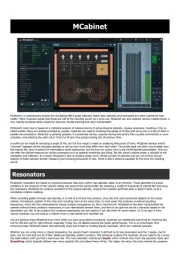
10 December 2024
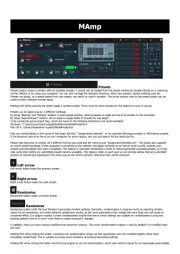
5 Augustus 2024

11 Juli 2024
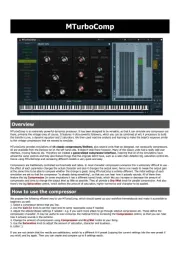
13 Maart 2024

13 Maart 2024

13 Maart 2024

12 Maart 2024
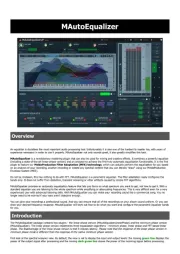
12 Maart 2024
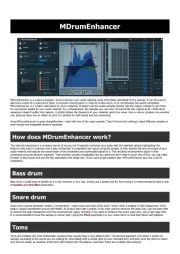
12 Maart 2024
Handleiding Audiosoftware
- Audio Ease
- SONORIS
- Dear Reality
- MIA Laboratories
- Magix
- EastWest
- Wave Arts
- CEDAR
- MixVibes
- Audiomodern
- Cherry Audio
- Roland
- BABY AUDIO
- TAL Software
- Minimal Audio
Nieuwste handleidingen voor Audiosoftware

3 September 2025
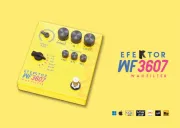
2 September 2025
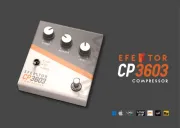
2 September 2025

1 September 2025
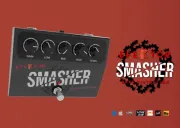
1 September 2025

1 September 2025
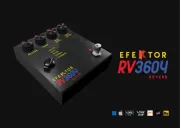
1 September 2025
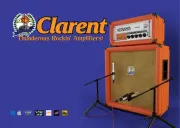
1 September 2025
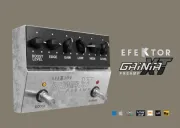
1 September 2025
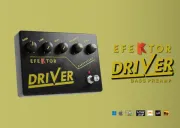
1 September 2025